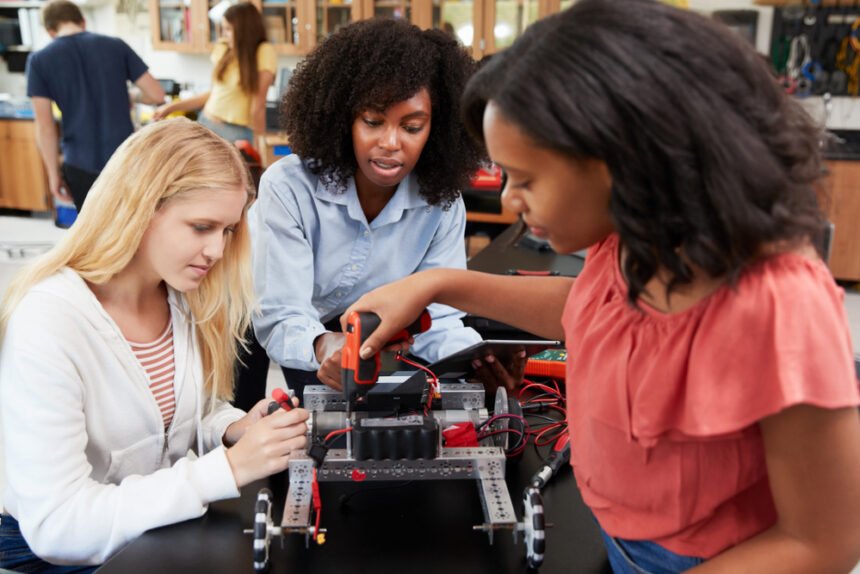In case you didn’t know, STEM education stands for science, technology, engineering and math, and it’s present in most schools in some form. While STEM conversations and emphasis on the various subjects often happens around high school and university students, it’s important to remember that STEM can actually be widely beneficial for younger kids, too.
When introduced in the elementary years, STEM education can help with child brain development in so many ways. Even if kids aren’t exactly STEM inclined, they still can gain a lot from using it as a learning tool. While subjects like art, music and reading are all key pieces in brain development for kids, STEM education works different parts of the brain, and can provide a well-rounded educational experience. While every child is different and will likely approach STEM subjects in a unique way, guiding them through their process can pay off big time later on. It could potentially have even more important mental health benefits such as fighting obesity by reducing depression.
1. Problem Solving Skills
One of the most important ways that STEM education helps with brain development is by teaching kids how to work through and solve problems. Specifically, math can be a great device for this, especially in younger children. However, all of the STEM subjects allow for creative problem solving and encourage kids to work through ideas to find the right solution to whatever task is in front of them.
When kids develop this skill early on, they can take it with them throughout the rest of life, even if the way they use it is not directly related to STEM. Problem solving skills are useful in so many places, and STEM helps to hone them. This can clearly boost your child’s cognitive reasoning.
2. Encouraging Teamwork
While plenty of subjects can encourage teamwork, STEM is one of the top few. Not only does STEM allow for students to work together in groups and coexist with one another, but it also puts them in a position to work together towards a specific goal or outcome. Together, kids can test different answers, theories and hypotheses to work towards a solution to a common problem. This is a skill that can benefit children in many areas of life, and they can take it with them into adulthood.
3. Tech Literacy
One unique skill that STEM can offer students is tech literacy. There is a difference between tech dependence and tech literacy, and STEM helps kids both understand the distinction and use it to their advantage. When kids learn how to work with technology and use it to learn from a young age, it makes it easy for them to use those same skills and adapt them with time and new mediums. By teaching kids to code, understand complex computer systems and even build their own tech, they’ll be able to build upon those skills for years to come. Plus, they’ll have a valuable professional skill.
4. Adaptation
Another valuable skill that STEM education helps kids build is the ability to adapt to changing situations, problems and circumstances. In STEM — both the education and the practical related fields — problems and circumstances change regularly, and in order to solve them, the student must adapt to the new environment and use what they already know to solve a new problem in front of them. This teaches them to carry principles over to new environments and adapt to changing problems, which can help them in many areas of life.
5. Encouraging Experimentation
Creativity isn’t always the first thing that comes to mind when discussing science, math, engineering or technology, but those subjects can often unlock a different kind of creativity: experimentation. Through STEM, kids can learn how to test new ideas, experiment and develop their own systems. It engages a combination of knowing the rules and principles that make things work, and trying out brand new ideas that are unique to each student. This can teach them to think innovatively and go outside the box while building upon the principles they already know.
6. Resilience
While STEM can be uniquely creative, systems of science and math still have rules to abide by. This is one of the ways that STEM can help child development unlike humanities and arts subjects. While arts, language and other “soft subjects” encourage creativity and exploration, they often do so under the idea that there is no right answer or that there can be many right answers — and this can help kids find the freedom to use their imagination and creativity to its fullest potential.
However, one of the best ways to compliment this approach is with STEM and its inclination towards teaching resilience. Unlike humanities, STEM subjects often do have only one right answer, and STEM subjects encourage students to use their problem solving skills and creativity to keep trying until they find it. It teaches kids to keep striving for the right outcome, and that getting it wrong doesn’t mean they should give up.
STEM Education Helps Child Development
There are so many ways that STEM education can help kids grow their minds and become even better learners in the world. From teamwork to resilience, STEM can help all kinds of students learn valuable skills and develop their growing minds.









